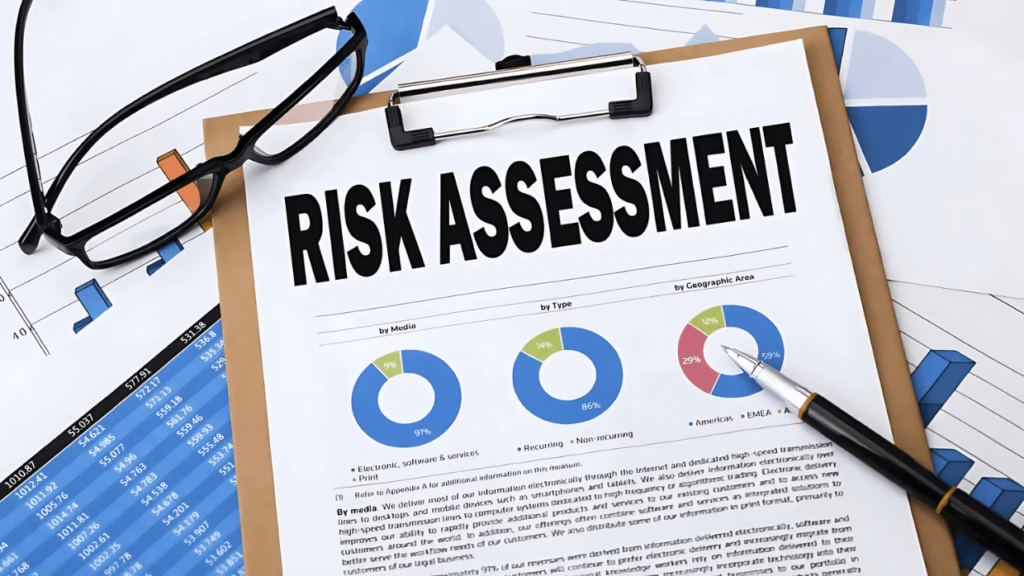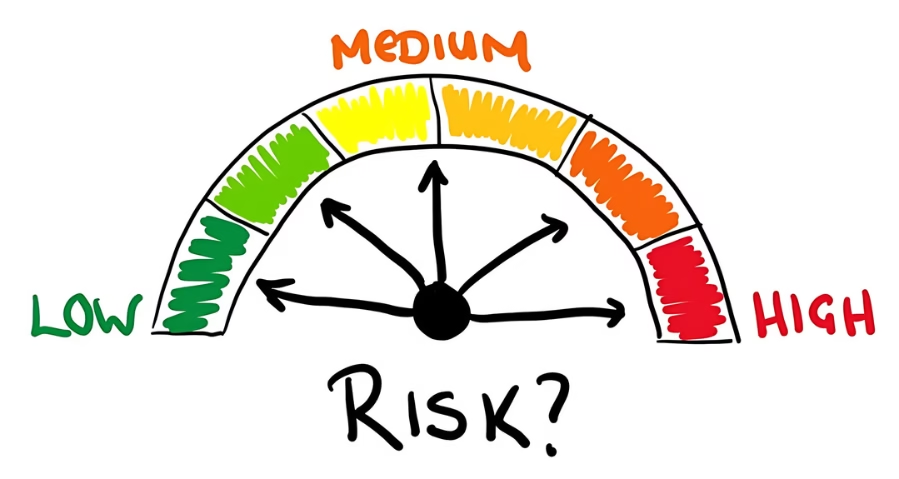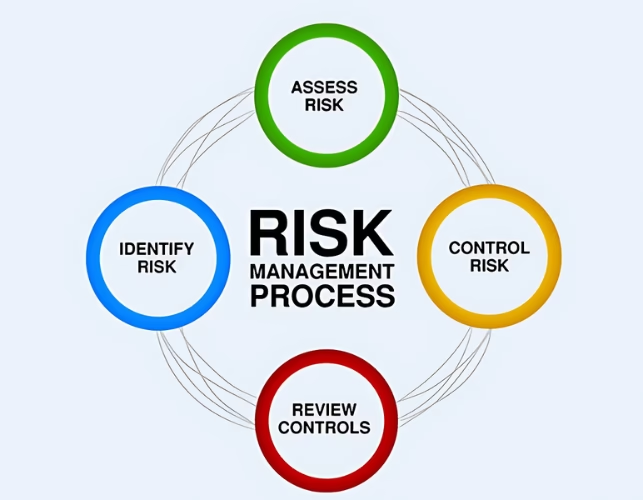Risk management plays an essential role in sound investment planning. By identifying, assessing, and mitigating potential threats, individuals and businesses can protect their financial goals. As markets evolve and uncertainties increase, mastering risk management becomes increasingly important for wealth preservation and growth.
In today’s dynamic financial landscape, understanding risk management helps investors minimize losses and maximize returns. Mastering the principles of effective risk management enables investors to navigate volatility confidently. This article will dive into low-risk investment strategies for beginners, explain their significance, and outline best practices to ensure long-term financial success.

Introduction to Risk Management in Investments
Risk management refers to the process of evaluating potential financial threats and implementing strategies to reduce their impact. For individual investors, this often involves safeguarding personal savings, retirement funds, and other assets from market volatility. For institutions, risk management focuses on protecting large-scale portfolios and client assets. Both approaches aim to balance financial security with growth potential.
Investment risks can be categorized into three main types: market risk, credit risk, and liquidity risk. Market risk stems from changes in market conditions, impacting asset values such as stocks, bonds, or real estate. For example, economic downturns can cause stock prices to plummet. Credit risk arises when borrowers default on loans, which can affect bondholders or lenders. Liquidity risk refers to challenges in selling assets without incurring significant losses. For instance, in a market downturn, real estate investments might become difficult to liquidate without substantial losses. Each type of risk requires tailored strategies to mitigate its effects.
By actively addressing these risks, investors can create low-risk investments that align with their financial goals. Risk-free investment options, such as government bonds or high-yield savings accounts, offer a secure foundation for building wealth. Learning how to invest money safely in 2025 will enable investors to make decisions that promote both security and profitability in their portfolios.
Risk Assessment and Mitigation Strategies
Risk assessment involves identifying, evaluating, and prioritizing potential threats to an investment portfolio. For beginners, this process typically starts by analyzing risk tolerance—understanding how much uncertainty one can comfortably handle—and adjusting strategies accordingly. Risk assessment tools can help investors visualize potential outcomes and make more informed, data-driven decisions.
Effective risk mitigation strategies include diversification, which is a cornerstone of portfolio management. Spreading investments across multiple asset classes—such as stocks, bonds, and real estate—helps reduce exposure to market volatility. For example, a balanced portfolio might allocate 50% to stocks, 30% to bonds, and 20% to real estate. This mix ensures that even if one asset class performs poorly, the overall portfolio remains stable.
When it comes to index funds vs mutual funds for beginners, index funds can be a better option. They offer lower fees, broader market exposure, and often have better long-term returns than actively managed mutual funds. These funds are designed to track the performance of an index, reducing the risk of underperforming the market.
Other techniques for mitigating risk include:
- Strategic Investment Mix: This guide helps investors balance their investments according to specific goals, time horizons, and risk tolerances, ensuring the portfolio aligns with long-term financial objectives.
- Risk Management Investment Techniques: These techniques include using insurance products like annuities or portfolio insurance to offset potential losses.
- Portfolio Protection Strategies: This involves incorporating defensive assets, such as precious metals or inflation-protected bonds, to safeguard against economic shifts and market fluctuations.
Together, these strategies create a financial safety net, helping to offer stability during times of uncertainty while fostering wealth-building potential.

Investment Risk Assessment Tools
Investment risk assessment tools are vital for any investor looking to manage their portfolio effectively. Tools like Monte Carlo simulations allow investors to model different market conditions and assess the potential risks of various investment strategies. These simulations can help visualize the potential outcomes of investments, assisting in making more informed decisions.
Moreover, platforms offering wealth management services provide automated strategies that optimize risk-reward ratios. By leveraging these tools, investors can better assess the risks associated with their portfolio, ensuring it aligns with their financial goals and risk tolerance.
Risk Management Frameworks and Tools
A structured framework is crucial for long-term success in investments. Leading models such as the ISO 31000 and COSO frameworks provide comprehensive approaches to risk management, offering guidance for both individual investors and large institutions.
The rise of investment risk assessment tools has revolutionized modern investing. Platforms equipped with risk analytics now provide real-time insights into market conditions and potential risks. These tools help investors better understand the risk-reward ratio of their portfolios, allowing for more strategic and informed decision-making.
Examples of useful tools include:
- Investment Risk Assessment Tools: Tools like Monte Carlo simulations can predict various portfolio outcomes based on historical data and potential market movements, helping investors plan for a range of future scenarios.
- Wealth Management Platforms: These platforms automate investment strategies and optimize investment mix, offering a hands-off approach for novice investors while ensuring a diversified portfolio.
By incorporating these tools, investors can make decisions that prioritize both safety and profitability, helping them stay on track toward their financial goals.
Best Practices for Effective Risk Management
To master risk management, consistency and education are key. Investors should start with clear policies that define acceptable levels of risk and measurable financial goals. Regular financial planning reviews help ensure that strategies stay aligned with market conditions, enabling investors to adjust their portfolios proactively as new information becomes available.
Best practices for risk management include:
- Recession-Proof Investment Strategies: Select assets that are resilient to economic downturns, such as utilities, healthcare stocks, or consumer staples, which tend to remain stable even in challenging market conditions.
- Wealth Preservation Techniques: Focus on income-generating investments, like dividend-paying stocks, fixed annuities, and rental properties, that provide steady cash flow while maintaining the value of the initial capital.
- Financial Risk Management Training: Staying informed about emerging threats and opportunities helps investors understand market changes. Continuous learning through financial webinars, books, and online courses will help enhance an investor’s ability to manage risks effectively.
The key to success is to continuously adapt, maintaining a flexible approach to protect wealth and build long-term financial independence.
Strategic Asset Allocation for Beginners
Strategic asset allocation is a critical part of building a well-diversified portfolio. For beginners, it’s important to understand the significance of balancing risk with reward. A well-thought-out asset allocation guide helps investors distribute their investments across various asset classes, such as stocks, bonds, and real estate. This diversification reduces the likelihood of large losses during market downturns.
Investors should also factor in their time horizon and risk tolerance when setting up their portfolio. By regularly reviewing their allocations and adjusting based on market conditions, they can ensure their investment strategy remains aligned with their long-term financial goals, thus protecting their wealth.

Types of Risk and Their Impact
Financial risks can significantly impact wealth if they are not properly managed. Each risk type requires a unique strategy to minimize its effects, making it crucial to understand how to protect investments from these risks.
- Strategic Risks: These risks affect long-term goals and can require adjustments in planning or strategy. For example, a business expansion might fail due to market oversaturation or regulatory changes.
- Operational Risks: These arise from internal inefficiencies, such as production delays or IT system failures, which could hurt profitability. A manufacturing delay can cause disruptions in the supply chain, reducing revenue.
- Compliance Risks: These expose investors to legal and regulatory penalties. Understanding legal requirements and ensuring investments meet regulatory standards can help mitigate compliance risks.
Low-risk investment strategies can help minimize the impact of these concerns. By selecting safe investment strategies in 2025, such as treasury bonds, diversified mutual funds, and certificates of deposit (CDs), investors can focus on capital protection while still achieving moderate growth. These safe investments are crucial components of a risk management investment plan.
Recession-Proof Investment Strategies
During economic downturns, implementing recession-proof investment strategies becomes essential. These strategies focus on assets that tend to perform well even when the market is struggling. Sectors like utilities, healthcare, and consumer staples remain in demand regardless of economic conditions, making them resilient investments.
Additionally, investing in inflation-protected bonds can help safeguard capital during periods of rising inflation. These bonds adjust with inflation rates, ensuring that investors’ purchasing power remains intact. By incorporating such assets into their portfolio, investors can weather economic storms and protect their financial future.
Diversifying Investment Portfolio for Long-Term Success
Diversification remains one of the most effective ways to reduce risk and enhance portfolio stability. By balancing investments across industries and geographical regions, investors can minimize exposure to concentrated risks.
Safe and profitable investment options for a diversified portfolio include:
- Government-backed securities: These offer low risk and provide capital preservation while earning steady returns.
- Dividend-Paying Stocks: These stocks offer regular payouts, providing investors with consistent income while enjoying the benefits of long-term capital growth.
- Real Estate Investments: High-demand markets with stable property values can offer predictable rental income and long-term appreciation.
A well-diversified portfolio—combining different asset classes like stocks, bonds, and real estate—provides a safety net against volatility. For example, investing in utility companies for reliable dividends or real estate investment trusts (REITs) for passive income ensures that your portfolio remains stable while generating returns.

How to Invest Safely with High Returns
While all investments come with some level of risk, there are ways to invest safely with high returns. One strategy is to focus on dividend-paying stocks. These investments provide regular payouts, helping to create a steady income stream while also offering potential for capital appreciation over time.
Another option is to explore real estate investment trusts (REITs), which offer exposure to property markets without the need for direct property ownership. These vehicles combine the benefits of real estate with the liquidity of stocks, providing a safe, yet profitable, investment opportunity. With careful planning and research, investors can achieve substantial returns without taking on excessive risk.
Profitable Investment Ideas with Low Risk
Identifying profitable investment ideas that prioritize safety requires research, creativity, and a deep understanding of market trends. For conservative investors, these strategies may include:
- High-Yield Savings Accounts: These offer competitive returns without direct exposure to market fluctuations.
- Fixed Annuities: These provide guaranteed income for retirees, offering stability in uncertain markets.
- Exchange-Traded Funds (ETFs): ETFs focused on dividend aristocrats offer steady payouts from companies with a proven track record of consistent dividend increases.
Looking ahead, it is also important to consider future-proof investment plans that ensure adaptability to evolving sectors like technology and green energy, where managed risks often present opportunities for growth.
Future-Proof Investment Plans
Future-proof investment plans are designed to withstand market disruptions and adapt to changing economic conditions. As industries evolve, focusing on sectors like technology, green energy, and healthcare can provide growth opportunities while minimizing risk. These sectors are not only resilient but also poised for long-term growth due to their alignment with global trends and demands.
To create a future-proof portfolio, investors should emphasize diversification across emerging markets and sectors with sustainable growth potential. Combining traditional safe investments with innovative sectors ensures stability, allowing investors to build a robust portfolio that thrives in both the short and long term.
Wealth Building through Safe Investment Strategies
Building wealth doesn’t require high-risk strategies. By investing in safe, steady assets over time, investors can harness the power of compounding interest. For instance, reinvesting dividends from blue-chip stocks can generate significant returns over decades.
By focusing on long-term investments and avoiding speculative investments, you can build financial security without taking unnecessary risks. Wealth management strategies, such as focusing on conservative investment strategies allow for gradual yet consistent growth, leading to financial independence over time.
Investment Protection for Financial Independence
Protecting your investments is crucial to long-term success. Using techniques like insurance products, hedging, and diversified allocations helps minimize the risk of losing capital.
Investment protection strategies ensure that your portfolio remains safe even during economic downturns, securing your financial future. Combining these strategies with effective risk management allows you to maintain your wealth and work toward financial freedom with confidence.
Safe Investment Strategies in 2025
As the financial landscape evolves, it’s important to consider safe investment strategies in 2025. These strategies ensure stability in uncertain times while still offering potential for growth. For investors looking to balance security with returns, focusing on government bonds, blue-chip stocks, and real estate investments provides a solid foundation. These assets offer consistent performance and can withstand market fluctuations, making them ideal for individuals seeking wealth preservation techniques.
When choosing stable investment options, it’s essential to prioritize instruments that have a proven track record. This includes sectors like utilities and healthcare, which are often less impacted by market volatility and economic downturns. With a strategic approach, investors can protect their capital while still benefiting from steady returns.

Conclusion: The Importance of Risk Management in Business
The importance of risk management in business cannot be overstated. It is essential for safeguarding assets, ensuring compliance, and achieving strategic objectives. By implementing robust risk management practices, organizations can navigate uncertainties and enhance their resilience in a dynamic business environment.
Risk management is a crucial aspect of business operations, as it enables organizations to identify, assess, and mitigate potential risks that could negatively impact their goals and objectives.
By implementing effective risk management strategies, organizations can reduce the likelihood of unexpected events and minimize potential losses.
In conclusion, risk management is essential for achieving business objectives and ensuring long-term sustainability.
FAQ – Frequently Asked Questions about Risk-Proof Investing
What is risk management in investments?
Risk management refers to evaluating potential financial threats and implementing strategies to reduce their impact. It involves assessing market, credit, and liquidity risks to safeguard personal and institutional portfolios, balancing financial security with growth opportunities.
How can I minimize risk while maximizing returns?
Minimizing risk while maximizing returns can be achieved through diversification. Spreading investments across different asset classes, such as stocks, bonds, and real estate, reduces exposure to any single asset’s volatility and helps protect the portfolio from downturns in specific markets.
What are some low-risk investment strategies for beginners?
For beginners, low-risk investment strategies include government bonds, high-yield savings accounts, and diversified mutual funds. These options provide stability and moderate growth, helping investors avoid large losses while building wealth over time.
How does diversification protect my investment portfolio?
Diversification reduces risk by spreading investments across various sectors and geographic regions. This strategy ensures that if one asset or market underperforms, other parts of the portfolio may remain stable, reducing the overall impact on your wealth.
What are the best practices for building a risk-proof portfolio?
The best practices for building a risk-proof portfolio include setting clear financial goals, assessing risk tolerance, and regularly reviewing your portfolio. Incorporating recession-proof assets, such as utilities and healthcare stocks, and wealth-preserving investments, like dividend-paying stocks and annuities, helps maintain stability and ensure long-term growth.
How can I assess and mitigate investment risks effectively?
To assess and mitigate investment risks, you should use risk assessment tools like Monte Carlo simulations to predict potential outcomes, and diversify your portfolio to reduce exposure. Additionally, strategic asset allocation and portfolio protection strategies, such as using defensive assets, can further safeguard against market volatility.
Source: US News – Money | Related articles: Linkedin / Tumblr




